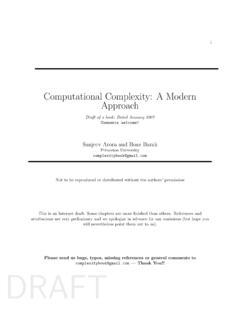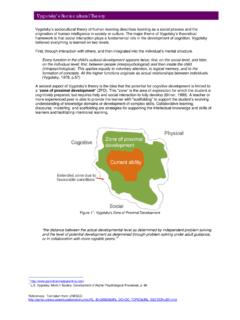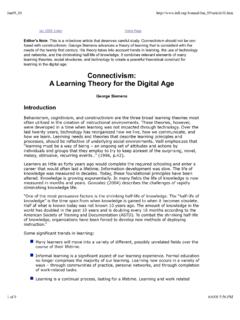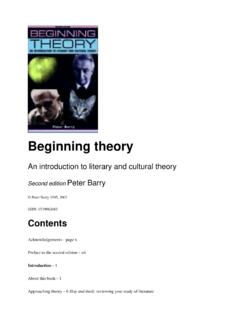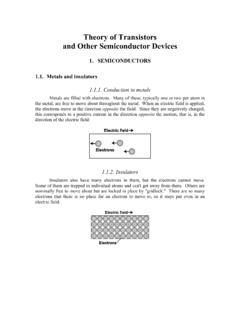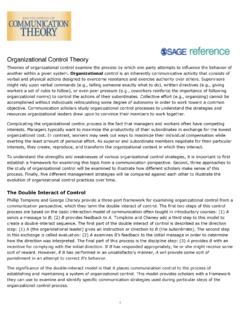Transcription of Computational Complexity: A Modern Approach - Theory
1 DRAFTiComputational complexity : A ModernApproachDraft of a book: Dated January 2007 Comments welcome!Sanjeev Arora and Boaz BarakPrinceton to be reproduced or distributed without the authors permissionThis is an Internet draft. Some chapters are more finished than others. References andattributions are very preliminary and we apologize in advance for any omissions (but hope youwill nevertheless point them out to us).Please send us bugs, typos, missing references or general comments Thank You!!DRAFTiiDRAFTA bout this bookComputational complexity Theory has developed rapidly in the past three decades.
2 The list ofsurprising and fundamental results proved since 1990 alone could fill a book: these include newprobabilistic definitions of classical complexity classes (IP=PSPACEand thePCPT heorems)and their implications for the field of approximation algorithms; Shor s algorithm to factor integersusing a quantum computer; an understanding of why current approaches to the famousPversusNPwill not be successful; a Theory of derandomization and pseudorandomness based upon com-putational hardness; and beautiful constructions of pseudorandom objects such as extractors book aims to describe such recent achievements of complexity Theory in the context ofthe classical results.
3 It is intended to both serve as a textbook as a reference for self-study. Thismeans it must simultaneously cater to many audiences, and it is carefully designed with that the book we explain the context in which a certain notion is useful, andwhythingsare defined in a certain way. Examples and solved exercises accompany key definitions. We assumeessentially no Computational background and very minimal mathematical background, which wereview in have also provided aweb sitefor this book related auxiliary material. This includes web chapters on automata and computability Theory ,detailed teaching plans for courses based on this book, a draft of all the book s chapters, and linksto other online resources covering related book is divided into three parts:Part I: Basic complexity volume provides a broad introduction to the field.
4 Start-ing from the definition of Turing machines and the basic notions of computability Theory , thisvolumes covers the basic time and space complexity classes, and also includes a few moremodern topics such probabilistic algorithms, interactive proofs and II: Lower bounds on concrete Computational part describes lower boundson resources required to solve algorithmic tasks on concrete models such as circuits, decisiontrees, etc. Such models may seem at first sight very different from Turing machines, butlooking deeper one finds interesting III: Advanced part is largely devoted to developments since the late 1980s.
5 Itincludes average case complexity , derandomization and pseudorandomness, thePCPtheoremand hardness of approximation, proof complexity and quantum every chapter in the book can be read in isolation (though we recommend readingChapters1,2and7before reading later chapters). This is important because the book is aimedWeb draft 2007-01-08 21:59 complexity Theory : A Modern Approach . 2006 Sanjeev Arora and Boaz Barak. References and attributions arestill many classes of readers: Physicists, mathematicians, and other group has become increasingly inter-ested in Computational complexity Theory , especially because of high-profile results such asShor s algorithm and the recent deterministic test for primality.
6 This intellectually sophisti-cated group will be able to quickly read through Part I. Progressing on to Parts II and IIIthey can read individual chapters and find almost everything they need to understand currentresearch. Computer scientists ( , algorithms designers) who do not work in complexity Theory per may use the book for self-study or even to teach a graduate course or seminar. All those professors or students who do research in complexity Theory or plan to do may already know Part I and use the book for Parts II and III, possibly in a seminaror reading course.
7 The coverage of advanced topics there is detailed enough to allow book can be used as a textbook for several types of courses. We will provide severalteaching plans and material for such courses on the book s web site. Undergraduate Theory of Computation I may be suitable for an undergraduatecourse that is an alternative to the more traditionalTheory of Computationcourse currentlytaught in most computer science departments (and exemplified by Sipser s excellent bookwith the same name [SIP96]). Such a course would have a greater emphasis on Modern topicssuch as probabilistic algorithms and cryptography.
8 We note that in contrast to Sipser s book,the current book has a quite minimal coverage of computability and no coverage of automatatheory, but we provide web-only chapters with more coverage of these topics on the book s website. The prerequisite mathematical background would be some comfort with mathematicalproofs and elementary probability on finite sample spaces, topics that are covered in typical discrete math / math for CS courses currently offered in most CS departments. Advanced undergraduate/beginning graduate introduction to complexity book canbe used as a text for an introductory complexity course aimed at undergraduate or non-theorygraduate students (replacing Papadimitriou s 1994 book [Pap94] that does not contain manyrecent results).
9 Such a course would probably include many topics from Part I and thena sprinkling from Parts II and III, and assume some background in algorithms and/or thetheory of computation. Graduate complexity book can serve as a text for a graduate complexity coursethat prepares graduate students interested in Theory to do research in complexity and relatedareas. Such a course can use parts of Part I to review basic material, and then move on to theadvanced topics of Parts II and III. The book contains far more material than can be taughtin one term, and we provide on our website several alternative outlines for such a hope that this book conveys our excitement about this new field and the insights it providesin a host of older draft 2007-01-08 21:59 DRAFTC ontentsAbout this (1)I Basic complexity (9)1 The Computational model and why it doesn t (11) Encodings and Languages: Some conventions.
10 (12) Representing objects as strings.. (12) Decision problems / languages.. (13) Big-Oh notation.. (13) Modeling computation and efficiency.. (14) The Turing Machine.. (15) Robustness of our .. (19) The expressive power of Turing .. (22) Machines as strings and the universal Turing .. (22) The Universal Turing Machine.. (23) Uncomputable .. (25) The Halting Problem.. (25) Deterministic time and the .. (27) On the philosophical importance ofP.. (27) Criticisms ofPand some efforts to address them.
